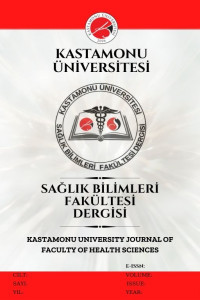Hemşirelerin Uygulama Eğitiminde Sanal Gerçekliğin Avantajları: Literatür Taraması
Teorik bilgi kadar pratik uygulamanın da önemli olduğu hemşirelikte, bu teorik bilginin uygulamaya aktarılmasında çeşitli yöntemler mevcuttur. Günümüz teknolojisiyle beraber sıklıkla kullanılan bu yöntemlerden birisi de simülasyon tekniğidir. Temelinde gerçek bir ortamı suni bir şekilde canlandırma mantığı olan simülasyon tekniği, hemşirelerin uygulama eğitiminde gün geçtikçe yerini almaktadır. Bu tekniğin bir dalı olan sanal gerçeklik, temelinde kişinin gerçekte içinde bulunmamasına rağmen oradaymış gibi hissetmesine dayanan ve bilgisayar tarafından oluşturulan bir ortamda olmasına olanak sağlayan bir yüksek gerçeklik simülasyonudur. Sanal gerçeklik, bilgisayar video iletimi yoluyla üç boyutlu bir sanal alan yaratan bir teknolojidir. Sanal gerçeklik teknolojisi, kullanıcı ve çevre arasında yoğun bir etkileşim oluşturur, dolayısıyla kişinin kendini o ortamda hissetmesine ve uygulamasına olanak sağlar. Sanal gerçeklik eğitiminin avantajları yapılan çalışmalarda açıkça ortaya konmuştur ve literatürde bu konu iyi desteklenmiştir. Yüksek riskli prosedürlerde düşük anksiyete ve yüksek motivasyon ile eğitim, nadir meydana gelebilecek klinik olaylar üzerinde sınırsız tekrar imkanı, maliyet açısından uzun vadede diğer klinik beceri laboratuvarları ile kıyaslandığında daha uygun olması, konum ve zaman açısından herhangi bir yerde uygulanabilmesi ve hastaya zarar vermeden eğitim uygulama fırsatı sağladığı için güvenli bir ortam sağlaması bu teknolojinin avantajları arasındadır.
Anahtar Kelimeler:
Hemşirelik, Sanal Gerçeklik, Eğitim Teknolojileri
Advantages of Virtual Reality in Nurses' Practice Education: Literature Review
In nursing, where practical application is as important as theoretical knowledge, there are various methods for transferring this theoretical knowledge into practice. One of these methods, which is frequently used with today's technology, is the simulation technique. The simulation technique, which is based on the logic of artificially recreating a real environment, is taking its place in the practice training of nurses day by day. Virtual reality, a branch of this technique, is basically a high-fidelity simulation that allows the person to be in a computer-generated environment, based on the feeling of being there despite not actually being in it. Virtual reality is a technology that creates a three-dimensional virtual space through computer video transmission. Virtual reality technology creates an intense interaction between the user and the environment, thus allowing the person to feel and practice in that environment. The advantages of virtual reality education have been clearly demonstrated in the studies and this subject has been well supported in the literature. Education with low anxiety and high motivation in high-risk procedures, unlimited repetition possibilities on rare clinical events, more convenient in terms of cost compared to other clinical skills laboratories in the long term, can be applied anywhere in terms of location and time, and the opportunity to practice training in a safely environment without harming the patient are some of the advantages of this technology.
Keywords:
Hemşirelik, Sanal Gerçeklik, Eğitim Teknolojileri,
___
- Adefila, A. Graham, S., Clouder, L., Bluteau, P., Ball, S., 2016. myShoes – the future of experiential dementia training? The Journal of Mental Health Training. Education and Practice 11, 91–101.
- Barteit S, Lanfermann L, Bärnighausen T, Neuhann F, Beiersmann C. Augmented, Mixed, and Virtual Reality-Based Head-Mounted Devices for Medical Education: Systematic Review. JMIR Serious Games 2021 Jul 08;9(3):e29080
- Berndt, J., 2014. Patient safety and simulation in prelicensure nursing education: an integrative review. Teach. Learn. Nurs. 9, 16–22
- Başlangıç: 2022
- Yayıncı: Kastamonu Üniversitesi
Sayıdaki Diğer Makaleler
Hemşirelerin Uygulama Eğitiminde Sanal Gerçekliğin Avantajları: Literatür Taraması
Sabri Okan DEMİRYÜREK, Semanur ÇELİK DEMİRYÜREK
Türkiye’de Fiziksel Tespit Uygulamasına İlişkin Yapılmış Hemşirelik Tezlerinin İncelenmesi
TAŞKÖPRÜDE YETİŞTİRİLEN TIBBİ NANENİN ANTİOKSİDAN ÖZELLİKLERİNİN BELİRLENMESİ
Yaşlanan Hemşirelik ve İş Gücü
Vücut Ağırlık Kontrolünün Sağlanmasında Telenütrisyon Danışmanlığı: Olgu Sunumu
